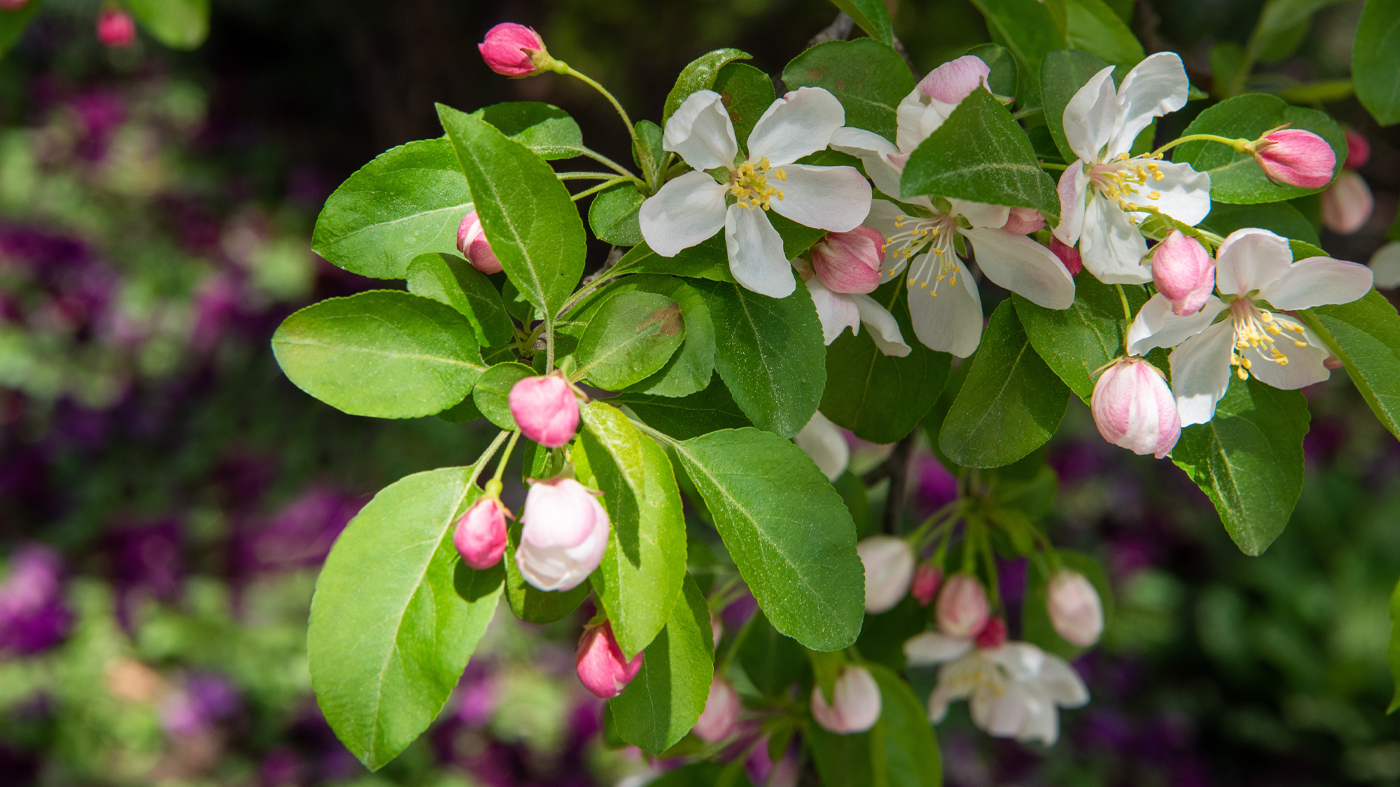

Crabapples
Malus
Flowering crabapples highlight the spirit of spring. Prized for their profuse display of flowers in April and May, these ornamental trees boast a variety of sizes, shapes and forms from dwarf and weeping to mounding, wide-spreading and upright.
Besides the spring flowers, the display is followed again in late summer with colorful fruits, providing for two seasons of outstanding interest. And, let’s not forget winter, when snow or ice sits on the berries, offering another attractive sight. These versatile trees are effective planted as a single specimen or in groups. There are smaller varieties suitable for urban sites as well as for foundation and border plantings.
Species and Cultivars
Crabapples belong to the genus Malus, a group of small flowering deciduous trees and shrubs in the Roseaceae (rose) family. There are more than two dozen species of crabapples found in North America, Europe and Asia. More than 500 cultivars have been developed over the past 150 years. The trees have been hybridized so often that many are just described as Malus x ‘Cultivar Name’ because their origin is unknown.
The Garden is home to more than two dozen crabapple cultivars. Some of the best include Donald Wyman, a consistent performer and disease-resistant cultivar that is extensively planted throughout the Garden. It was discovered as a chance seedling at the Arnold Arboretum of Harvard University in the early 1950s and named in honor of Donald Wyman, Ph.D., who had recently retired as horticulturist at the Arboretum.
Donald Wyman has reddish-pink buds that open to white flowers. The fruit is glossy red and persists into winter. Weeping Sargent crabapple is a pendulous form of the low, spreading Sargent crabapple suitable for a shrub border or rock garden. Walters Siberian crabapple has pink buds opening to pale pink flowers that fade to white and are followed by gold fruits.
Flowers
The majority of crabapples have five-petaled, single blossoms, but some varieties have semi-double or double blossoms. Bud color ranges from pure white to dark purple-red with many variations. The flower color may be different than that of the bud. Depending on the cultivar, flowers may be pink, coral-pink, coral-red, light purple-red, white, or pink and white. A bonus—flowers attract pollinators and some blossoms have a light, spicy scent.
Fruits
Crabapples put on a second show in late summer with fruits that are yellow, bright red, dark purple-red, maroon, gold or a brilliant orange. Fruits may be as small as a pea to two inches across. Some varieties drop the fruits in fall while others hold them through winter. Birds often seek the fruits after they’ve softened with freezing temperatures.
Form and Foliage
Crabapples are generally small trees, less than 20 feet tall. However, some varieties can reach 30 feet or more. There is considerable variation in their form. They may be columnar—very upright—until the fruits weigh the outer branches down in summer. Or, they can be pendulous, weeping like the popular weeping cherry, but much longer lived. Or, they can be vase-shaped, oval, mounded or shrubby. Leaves are generally green, but some cultivars hold a red to bronze color during the growing season.
Cultivation
Crabapples are very adaptable to different types of soil as long as it drains well and there’s no standing water. Give them a spot in full sun although some will tolerate partial shade. Better flowering and fruiting occurs with at least six hours of direct sun. If you need to prune the tree to remove water sprouts—upright shoots—or broken or crossing branches, do it right after the flowers have finished. Most crabapples initiate the flower buds for the following year in mid-June to early July. If you prune after that time, some of the next year’s flowers will be removed.
Native Crabapples
In Illinois, the Prairie Crabapple (M. coronaria) is found in several counties, often on the edge of the woods, fields and prairies. This tree is said to have inspired Chicago landscape architect Jens Jensen. The close-grained wood has been used to make tool handles. The flowers are intensely fragrant and although the tree tolerates ice storms, high winds and drought, the leaves are subject to insects and rust disease, which causes the foliage to drop in spring.
The Iowa Crabapple (M. ioensis) is found in every county throughout Illinois growing along the edges of prairies and fields. It can reach 25 feet tall with a one-foot diameter trunk. Showy two-inch-wide flowers may be white or rose and the small yellow-green apples have been used to make jelly.
Pests and Diseases
Crabapples are sometimes overlooked because some—especially older varieties—are very susceptible to disease, especially after a wet spring. And all of the native species are susceptible to cedar apple rust, which causes unsightly brown spots on the leaves.
Fireblight, apple scab, cedar apple rust, scale, borers, apple scab, canker and aphids may pose problems. Apple scab is a predominant disease caused by a fungus that infects the leaves and fruit. The infection occurs early in spring and often results in bare trees by late summer. Many newer cultivars have been bred for disease resistance. Before you purchase a tree, check on its disease resistant qualities as well as its size and shape.
Have a crabapple that’s experiencing problems? The Plant Clinic can help.
Take a stroll and enjoy crabapples at several locations in the Garden.




